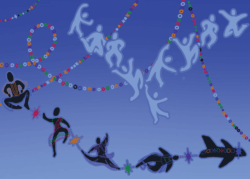If it weren’t for the orange and black signs hanging outside, the District of Columbia Arts Center (DCAC) would be virtually invisible. A solitary door squashed between a junk shop and a pizza place opens to reveal stairs that lead to a shoebox of a gallery and, behind it, a pin box of a theater, which collectively comprise the District’s self-proclaimed “hub of alternative activity.”
DCAC, a non-profit gallery, theater, and educational center for artists and aspiring artists, bears all the characteristics of a makeshift, underground movement. One must venture outside in order to enter the theater, which used to be a garage. Meanwhile, the 750-square-foot gallery’s whitewashed walls reflect the open-ended, artist-centered vision that DCAC’s founder, Herb White (SFS `57), strived for from the time he founded the Center in 1989 until his death in June 2007.
“Herb’s mission was nebulous at first,” DCAC Executive Director B. Stanley said. “But he never interfered with or questioned what I or anyone else here decided to do with the place. Our mission is to provide under-served artists in all areas a place to practice their work.”
DCAC provides a space for emerging artists who can’t display their work in the District’s commercial galleries, according to Suzan Harjo, who curated DCAC’s spring 2008 exhibition, “American Icons in Indigenous Eyes.” “It informs the existing audience, attracts new audiences, and energizes local artists,” she said.
DCAC’s history sets it apart from the more mainstream galleries, too. The Center’s existence is the product of a backlash against the changing direction of mainstream arts support in D.C. in the late 1980s. When several members of the Washington Program for the Arts, including future DCAC founder White, felt that the organization had abandoned its commitment to supporting local artists.
“WPA began applying for more money [and] local artists were left out,” Stanley said.
WPA was established in 1975 to support local artists, but several members of WPA’s board accused the organization of abandoning its District focus after several other members expressed a desire to give the controversial Robert Mapplethorpe exhibit, “The Perfect Moment,” a more national appeal and change its original D.C. emphasis, according to CultureFlux, an online D.C.-based arts publication. In protest over that decision, Stanley said, White and around ten other WPA board members broke away to found DCAC.
“Herb saw a loss in the city when he moved here [in the early 1980s] and thought DCAC might be a way to fill that hole,” Stanley said.

While no starving artist himself, White dedicated his life in D.C. to supporting DCAC’s artists in any way he could, whether that meant buying their work or offering his home for studio space, where he charged no rent and gave artists a monthly stipend.
White’s grandson, Will Schneider-White, recalled that his grandfather seemed to be so committed to supporting artists themselves, that he hardly critiqued their work, even those pieces he purchased for his substantial collection.
“He never talked about what he liked or didn’t like about the art,” Schneider-White said. “It was as though he was trying to collect the artists themselves … DCAC was and remains an extension of my grandfather, and he thought of it as such; just another thing he could do to help the artists of D.C.”
If DCAC is an extension of White, the “Herb’s Choice” exhibitions—soon to be called “Herb’s Grant”—continue that intimate connection, even after his death. Schneider-White’s art is currently showing in the last “Herb’s Choice” exhibition. The exhibit, “Anhedonia,” which runs through October 12, is strikingly minimalist compared to DCAC’s past exhibitions, which have included plenty of three-dimensional pieces, including action figures in a July 2008 showcase called “Kid Mutiny.”
In contrast, “Anhedonia” consists solely of paintings and drawings mounted on the walls, which remain whitewashed. Schneider-White’s work features figures that only vaguely resemble humans, the contours of their bodies blending into dark backgrounds made with wide, rough paint strokes. The name of the exhibition, the artist, and the curator are printed in plain block letters, starkly black against the whiteness of the wall. No names accompany the paintings of humanoid figures reaching up out of abysses of dark paint; instead, a stack of guides to the pieces sits atop a white column. The guide reveals ambiguous titles such as “Marriage 2” and “Untitled 3.” No music accompanies visitors throughout their journey through the works, though it would be welcome comfort. The melancholy, often somewhat creepy nature of the pieces makes Herb’s last choice uncomfortably appropriate.
White dabbled in the arts as an undergraduate at Georgetown, but what he lacked in artistic talent, he more than made up for in eccentricity and spontaneity. After graduating, he joined the army to fight in Korea, hitchhiked across Vietnam, India, and Afghanistan, ran a coconut plantation in Panama, and served as a stand-in for Peter O’Toole during the filming of Lawrence of Arabia in Spain, according to Schneider-White. After returning stateside in the early 1980s, White opened two successful restaurants in Dupont Circleshy;—both named Herb’s Restaurant and successfully invested in several real estate projects. It was the success of White’s real estate ventures and his foray into the restaurant business that made it financially possible for him to open DCAC.
White opened Herb’s Restaurant in order to provide a venue for arts fundraisers and discussions among artists, according to Will Schneider-White.
“The food was never very good, but he had a room in the back that he used for fundraisers. He catered the food for free for organizations that had fundraisers there,” he said.
“Herb’s Restaurant was really a social activity more than anything else,” Stanley explained. “It was like his living room. If Herb saw someone interesting come in, he would go over and sit down with them. He meant it to be an artist’s hangout.”
In addition to funding DCAC through the revenue brought in by his restaurants and real estate projects, Herb provided a physical location for the Center. White rented the space to DCAC for $1 a year, according to DCAC’s website. However, Stanley explained that, characteristically, White never actually collected any money.
“It was just something to put on the lease because he couldn’t write ‘$0,’” he said.
White’s willingness to give to artists without expecting a penny back stemmed from a deep sense of philanthropy, according to Stanley.
“Herb was a wealthy guy from investing in real estate, but he always had a deep sense of obligation to give back to the community,” he said. “He used to take wealthy people aside and tell them, ‘Hey, you’ve gotten pretty rich; you better start giving back. You can’t just make money. You have to do something.’”
“When Herb moved to D.C., he fell into the fabulous crowd, which included wealthy women who supported art in order to give back. Herb picked up on that,” Stanley said.
Stanley said that, for White, DCAC was about more than philanthropy.
“He was always asking, ‘How can we celebrate art and have a good time?’ For Herb, that meant being with people. He wanted drunk people, kissing people, people with piercings. Anything you could dream up for a party, Herb would support. You want cross-dressing transvestites? Wonderful!”
Since DCAC opened it has hosted over 100 exhibitions and 500 performances, with about ten shows a year. According to Stanley, the Center strives to serve young, professional artists without commercial gallery representation by acting as the “first rung to a professional career,” according to Stanley.

In order to nurture this artistic growth, DCAC hosts many educational programs, specifically aimed at visual, spoken word, and musical artists and curators who hope to become professionals. The Curatorial Initiative, perhaps DCAC’s most ambitious educational program, exemplifies these efforts. Made possible by a $45,000 grant from the Andy Warhol Foundation for the Visual Arts, the program places aspiring curators, in apprenticeships.
Stanley hopes the Initiative will catalyze a trend towards lowering the cost to artists of showing their work, by providing stipends to the artist, the curator and the discussion facilitator.
“It’s just getting more and more expensive for artists to mount shows, and I hope we start a trend towards other galleries paying artists to present, even if they don’t sell,” Stanley explained in a press release announcing the Initiative.
In addition to placing a premium on fruitful discussion about art, a fundamental element of White’s vision for the Center was encouraging artists whose work might not fall into the mainstream mold. DCAC provides a space for artists to experiment without criticism, whether the result is successful or not.
Much like the gallery space, DCAC’s black box theater offers cheap performance space for emerging artists. The Landless Theater Company, founded in 1992, currently calls the Center home, staging quirky, campy productions like “Walmartopia,” a musical chronicling the trials of a single mom and Wal-Mart employee, who speaks out against her employer’s working conditions, only to find herself jettisoned to 2036, a world in which Wal-Mart exerts total control. Naturally, the production features the singing head of Wal-Mart founder Sam Walton. “President Harding is a Rock Star” and “Snoopy Dog and the Teenage-Gang Mysteries” round out the season, the latter a parody of Saturday morning cartoons, for adults only.
“It is important for us to generate young and new audiences through affordable theater, and Adams Morgan is the ideal community for us,” Andrew Baughman, Producing Artistic Director for Landless Theater Company, said. “DCAC stands as the truest alternative theater venue in D.C.”
Landless is a perfect example of the type of artists DCAC seeks to attract. Tactfully acknowledging that the Company has improved a lot since it first began to work with DCAC, Stanley stressed that the Center prides itself on allowing artists to experiment with their work without worrying that failed efforts will lead to exclusion from future consideration by the Center, although he added that Landless sells out almost every show these days.
Perhaps the best example of DCAC’s efforts to create an egalitarian artistic community is the annual “1460 Wall Mountables” exhibition. Anyone with $15 and an idea for how to fill a 2×2 space can contribute one of the 1,460 spaces with which DCAC fills the walls of its gallery for six weeks each year. The exhibit, which debuted in 1990, is the longest ongoing project at DCAC and one of the first the Center undertook.
Since becoming the Executive Director of DCAC in July 1994, Stanley has encouraged the development of the aspects of DCAC he values and has done away with those he believes to be detrimental to the development of art. Stanley explained that his predecessor, Andrew Mellon, focused on showing art that expressed the issues of the gay and lesbian community. Stanley decided to strip the Center of any discernible focus because he believes that “we shouldn’t be the gay and lesbian gallery any more than we should be the black gallery or the straight, white man gallery. Art shouldn’t be divided.”
In the future, Stanley hopes to expand the Center to include two galleries, but regardless of how much the Center grows, Stanley emphasized that it will never lose sight of its mission to serve D.C.’s under-represented artists.
“DCAC remains very dedicated to my grandfather, his contributions, and what he wanted the space to be,” Schneider-White said. “DCAC may change in cubic feet, but it will be a long time, if ever, before it changes in mission.”





